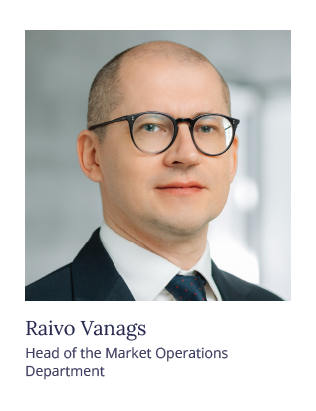Latvijas Banka manages its gold and financial investments in accordance with the investment management guidelines set by the Council of Latvijas Banka, observing the principles of prudent management. Investments are managed with the following long-term objectives:
- capital preservation;
- liquidity;
- income generation.
Investment management takes into account the principles of sustainability and adheres to the Agreement on Net Financial Assets between the national central banks of the euro area and the ECB.
Investment management framework
Investment management is carried out by both the employees of Latvijas Banka and external managers. Investments are made in three main asset classes: fixed-income securities, equities, and gold.
Investment composition
Diversification is one of the primary strategies used in investment management. Latvijas Banka mostly invests its financial assets in:
- debt securities issued by the governments of the US, Canada, and European countries, their agencies, or international institutions;
- asset-backed securities;
- securities in the emerging markets government securities index;
- securities in the global investment-grade fixed-income securities index;
- equities issued by companies in developed and emerging markets equity indexes;
- high-quality debt securities issued by corporate issuers;
The total value of Latvijas Banka's investment portfolios at the end of 2024 was 6.15 billion euro, which was 0.4 billion euro more than at the end of 2023.
Chart 1. Investment composition (31 December 2024; %)
Investment in fixed-income securities
The bulk of investment in fixed-income securities is managed by the employees of Latvijas Banka.
The benchmark of the 1–10 year fixed-income securities portfolio managed in-house consists of:
|
Term structure of government securities index |
Currency structure | |
|
US |
1–3 years |
55 % |
|
Euro area |
1–10 years |
21 % |
|
UK |
1–10 years |
14 % |
|
Canada |
1–3 years |
10 % |
Investments in investment-grade fixed-income emerging markets government securities are made by the employees of Latvijas Banka through exchange-traded funds (ETFs). In 2024, the benchmark portfolio of these investments was changed, redirecting it towards issuers with a higher rating according to environmental, social, and governance (ESG) criteria and green bond issuances.
Latvijas Banka also uses the services of seven external managers to manage investments in fixed-income securities. They manage a part of Latvijas Banka's financial assets in accordance with the guidelines set by the Council of Latvijas Banka.
- Six managers oversee the portfolios of US mortgage-backed fixed-income securities (US MBS).
- One manager handles the portfolio of investment-grade global fixed-income securities. In 2024, this portfolio was revised in accordance with the provisions of Article 8 of the Regulation on sustainability-related disclosures in the financial services sector.
The currency risk is hedged against the euro for all investments in fixed-income securities except for the investment-grade global fixed-income securities portfolio.
Investment in equities
Investment in equities mostly comprises the portfolio of equities from developed markets, which is managed by an external manager. This portfolio is managed in accordance with the developed markets equity index, and is subject to Latvijas Banka's sustainability strategy. Its targets are:
- to support the achievement of carbon neutrality by 2050 at the latest;
- to adjust the portfolio to the provisions of the Paris Agreement;
- to avoid environmental pollution, conserve biodiversity, and consider ESG factors (see report).
Investment in emerging markets equities is managed against the corresponding equity index and is made through ETFs.
Investment in gold
Latvijas Banka's gold is stored at the Bank of England.
Management of ECB reserves
Under the Statute of the ESCB and of the ECB, Latvijas Banka has transferred a small share of its gold and financial assets to the ECB to be managed as part of the ECB's foreign reserves. The ECB's reserves are managed by the national central banks of the Eurosystem, where each bank is allocated a share of financial assets to manage in accordance with their capital key1The ECB's capital consists of the contributions by all central banks of the EU Member States. The shares of the national central banks in this capital are calculated using a key which reflects the respective country's share in the total population and gross domestic product of the EU.
at the ECB. Together with Oesterreichische Nationalbank, Latvijas Banka manages their share in Japanese yen. Under the Statute of the ESCB and of the ECB, 1.1 tonnes of Latvijas Banka's gold have been included in the ECB reserves.
Risk management
Risk management is an integral part of investment management. Risk management means developing risk scenarios, assessing the potential returns on and risks of financial assets, and modelling the optimal allocation of assets. The investment portfolio compliance with the guidelines and risk distribution in accordance with investment decisions are monitored and controlled on a daily basis.
Interest rate risk is the most significant risk factor affecting Latvijas Banka's investments. The most significant financial impact on Latvijas Banka's investment composition stems from changes in 2, 5, and 10-year bond rates, as well as from changes in risk premiums (the interest rate spread between government securities and other securities). The second most significant risk factor is market price changes, particularly for developed markets equities. The Council of Latvijas Banka determines the permissible levels of interest rates, market prices, and other risks. These factors and the exposure of investments thereto are analysed daily by the employees of Latvijas Banka.
2024 in review
In 2024, unlike the previous two years, the central banks of the advanced economies reduced their base interest rates. The US Federal Reserve System and the ECB lowered their rates by 100 basis points, the Bank of England – by 50 basis points, and the Bank of Canada – by 175 basis points.
Chart 2. Development of central bank policy rates (%)
Sources: Bloomberg Finance LP, Latvijas Banka.
Note. The US rate is the average value of the base interest rates set by the US Federal Reserve System. The euro area rate is the ECB's deposit facility rate.
In 2024, interest rate volatility was lower year on year; yet, it remained relatively high. Volatility temporarily increased in April and August 2024. At the end of October and beginning of November, it reached its highest level of the year, which rapidly decreased after the US presidential elections.
Chart 3. US Bond Market Option Volatility Estimate (MOVE) index (index points)
Sources: Bloomberg Finance LP, Latvijas Banka
In 2024, the range of government securities yields (see Chart 55) in the investment markets of Latvijas Banka reflected the following essential trends:
- medium and long-term interest rates increased over the year (except for Canada's 5-year rate), while 2-year rates, except for the UK, declined;
- 2-year rates showed greater volatility compared to 5 and 10-year rates;
- the highest increases in medium and long-term rates were recorded in the UK, and the lowest – in Canada (5-year rates fell);
- the rates in the euro area remained lowest overall;
- in most markets, the yield curves normalised. In previous years, short-term (2-year) rates exceeded long-term (10-year) rates, while in 2024, long-term rates exceeded short-term rates in all markets reviewed.
Chart 4. Range of government securities yields in 2024 (yields; %)
Sources: Bloomberg Finance LP, Latvijas Banka.
The US yield curve remained inverted longer in recent years than at any time since 1976, only beginning to normalise at the end of 2024. Historically, an inverted yield curve has signalled weaker growth, ending in a recession; however, by the end of 2024, the market projected that strong economic growth would continue in the US.
Chart 5. Periods of a negative US Treasury yield curve (duration in weeks)
Sources: Federal Reserve Bank of St. Louis, Latvijas Banka.
After a significant decline in stock prices in 2022, the US equity markets were very strong in 2023 and 2024. This was the first time since 1999 that the total return on US stocks exceeded 20% for two consecutive years.
Chart 6. Periods in which S&P 500 has shown more than 20% total return for two consecutive years
Sources: New York University Stern School of Business, Latvijas Banka.
The bubble chart data (see Chart 7) reflect the dynamics of the returns on equities of issuers from various advanced economies in local currencies from 2022 to 2024. In 2022, the returns on most equity markets, particularly the largest ones, were negative. In 2023, the situation improved, and most equity markets achieved positive returns, with equities of issuers from some countries even exceeding 20%. This positive trend also continued in 2024, with strong growth across most equity markets. The dominance of the US equity market increased. For example, in the MSCI World index, the US share increased from 68% in 2022 to 74% in 2024 (the US data are also shown in Chart 10).
Chart 7. Dynamics of the returns on investments in equity markets of various advanced economies in local currencies (%)
Sources: MSCI, Latvijas Banka.
Note. The bubble size shows the relative size of the equity markets of advanced economies according to their capitalisation.
The gold price in 2023 and 2024 increased significantly, rising by 13.1% and 27.2% respectively in US dollars. Unlike other asset classes, the value of gold did not decrease in 2022. This underpinned its relatively strong return over 3 and 5-year periods (see Chart 8). In the last decade, gold has been a strong diversifier for investment portfolios. One of the main drivers for the rise in gold prices was the gold purchases made by individual central banks (the largest purchases in 2023 were made by the central banks of China, Poland, and Singapore, while in 2024 – by the central banks of Poland, Turkey, India, and China). Geopolitical uncertainty was an additional driver.
Chart 8. Annual returns on various asset classes over 1, 3, 5, and 10 years (%)
Sources: New York University Stern School of Business, Latvijas Banka.
Note. Equities represent the S&P 500 index, cash stands for the US 3-month fixed-income securities, 10-year securities denote the US 10-year fixed-income securities, while the gold price is expressed in US dollars.
Investment results for 2024
 The shorter the time period in which investment results are observed, the greater their volatility. Even calendar year results can be quite volatile.
The shorter the time period in which investment results are observed, the greater their volatility. Even calendar year results can be quite volatile.
The investment policy of Latvijas Banka is developed in accordance with the best practices implemented by central banks and aims to adhere to the fundamental principles of investment in the long term.
Investment diversification over the last five years, despite the decline in global financial asset values experienced in 2022, has ensured strong performance during this period.
2024 has so far been the most profitable year for Latvijas Banka in terms of investment management. Income from investment management reached nearly 400 million euro or 7%.
Chart 9. One-year investment returns (%)
Source: Latvijas Banka.
Latvijas Banka's investments are managed with the objective of ensuring compliance with the fundamental principles of management in the medium and long term. Although the market value of financial assets significantly decreased in 2022 due to the rapid interest rate rise (see Chart 10), the medium-term income from investment management remained high (see Chart 11).
Chart 10. Annual returns on the S&P 500 index and 10-year US Treasuries since 1928 (%)
Sources: Bloomberg Finance LP, ICE Data Services, Latvijas Banka.
Chart 11. Total 5-year economic profit of investments, rolling indicator (millions of euro)
Source: Latvijas Banka.










